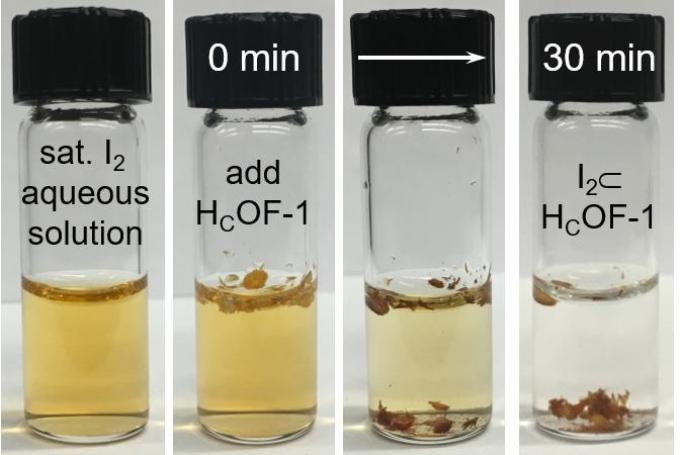Jun 8 2017
For the first time, Researchers have designed a novel microporous material that removes iodine from water. This major breakthrough presents new opportunities to cleanup radioactive waste found in nuclear reactors and subsequent to nuclear accidents, similar to the Fukushima disaster that occurred in 2011. The study was performed by a team of Researchers at Dartmouth College.
 Iodine is removed from an aqueous solution after the addition of HCOF-1. (Credit: Chenfeng Ke / Dartmouth College)
Iodine is removed from an aqueous solution after the addition of HCOF-1. (Credit: Chenfeng Ke / Dartmouth College)
The new-generation material developed by Dartmouth Researchers is the outcome of small, chemically stitching organic molecules to create a framework that scrubs or removes the isotope from water.
There is simply no cost-effective way of removing radioactive iodine from water, but current methods of letting the ocean or rivers dilute the dangerous contaminant are just too risky. We are not sure how efficient this process will be, but this is definitely the first step toward knowing its true potential.
Chenfeng Ke, Assistant Professor, Department of Chemistry, Dartmouth College
During the process of nuclear fission, radioactive iodine is produced as a standard byproduct. Radioactive iodine is also a pollutant in nuclear disasters, for instance the 1986 Chernobyl disaster and the recent meltdown in Japan. Although it is relatively common to remove iodine in the gas phase, this element has never been scrubbed from water until the Dartmouth research.
We have solved the stubborn scientific problem of making a porous material with high crystallinity that is also chemically stable in strong acidic or basic water. In the process of developing a material that combats environmental pollution, we also created a method that paves the way for a new class of porous organic materials.
Chenfeng Ke, Assistant Professor, Department of Chemistry, Dartmouth College
The study has been reported in the May 31th issue of the Journal of the American Chemical Society. It demonstrates how the Researchers exploited sunlight to crosslink tiny molecules in huge crystals to develop the novel material. This soft stitching method is completely different from the conventional approach that combines molecules in a single pot.
During the study, iodine concentrations were brought down from 288 ppm to 18 ppm within a span of 30 minutes and less than 1 ppm after a period of 24 hours. The new method produced a breathable material that changes shape and also adsorbs more than twice its weight of iodine. In addition, the Researchers discovered that the compound was also elastic which means it can be reused and may prove to be even more useful for cleaning the environment.
Similar to how salt is applied to contaminated water, the new compound could be used in the same way, informed Ke. Since the material is lighter than water, it floats to adsorb iodine and as it becomes heavier, it sinks gradually. Once the compound takes up iodine from water, it can be gathered, cleaned and reused, and the radioactive elements can be sent for storage.
For the experiment, the lab research utilized applied non-radioactive iodine in salted water but according to Researchers it can also be applied in real-world conditions. The team hopes that if the material is continuously tested, it may well be effective against cesium and other similar radioactive contaminants related to nuclear plants.
It would be ideal to scrub more radioactive species other than iodine--you would want to scrub all of the radioactive material in one go.
Chenfeng Ke, Assistant Professor, Department of Chemistry, Dartmouth College
Researchers at Dartmouth's Ke Functional Materials Group are also hoping that the method can be employed to develop new materials that target other kinds of organic and inorganic pollutants, predominantly antibiotics that are present in water supplies, because such drugs can lead to the development of super-resistant pathogens.